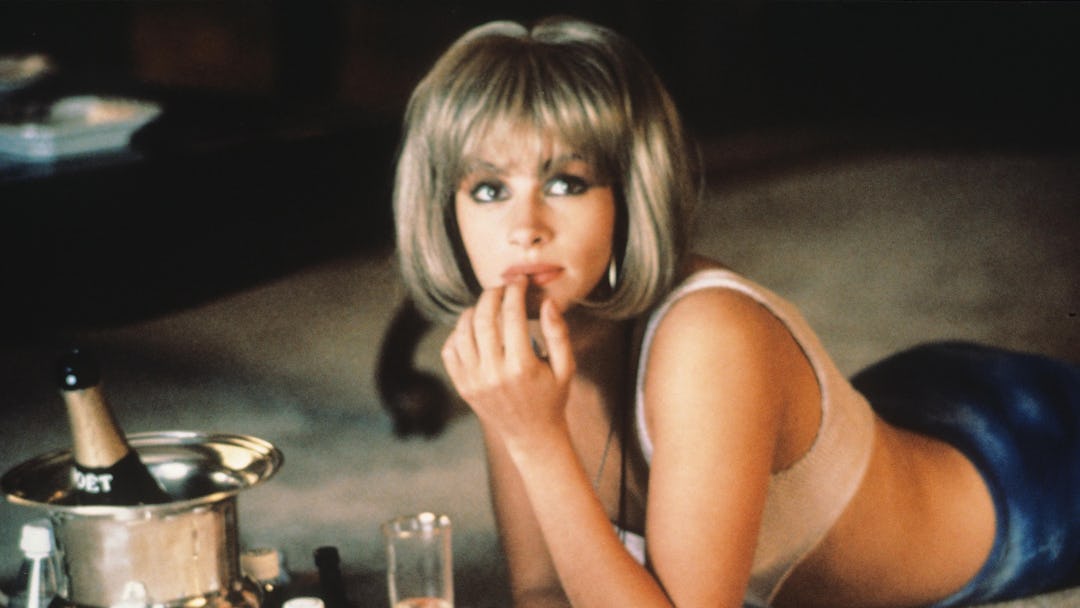Twenty-five years ago today, a small movie starring a has-been and an unknown crept into theaters and unexpectedly took America by storm. The Cinderella story of a Hollywood prostitute and the tycoon who becomes her knight in shining armor, it made Julia Roberts a star, made Richard Gere a star again, and made $463 million worldwide, contributing (along with the previous summer’s When Harry Met Sally ) to the glut of romantic comedies that would populate 1990s cinema. The movie was originally called $3,000, but you might know it by its second, Disney-imposed title, Pretty Woman. And that moniker wasn’t the only thing that changed between the page and the screen; in fact, Pretty Woman has become a legendary example of how a movie can come out of the studio, writing-by-committee system bearing very little resemblance to the script it once was.
J.F. Lawton’s original screenplay, titled $3,000 after the amount Edward (Gere) pays Vivian (Roberts) for her week-long engagement as his Los Angeles companion, was a hot property, bought after a fierce bidding war by Disney’s Touchstone Pictures division and handed over to director Garry Marshall, who’d just given them a hit with Beaches. Touchstone was established in 1984 as a home for more adult-oriented fare than Disney proper; their first release (and first hit) was that year’s Splash, and their first R-rated movie, Down and Out in Beverly Hills, followed two years later.
Still, $3,000 would’ve been mighty dark as written, even for Touchstone. In its original form, which you can read here, it was neither a Cinderella story nor a romantic comedy — it was a cynical, rather depressing tale of a junkie prostitute and the rich asshole she spends a week with. Neither of them is particularly likable, either at the beginning of the story or its conclusion; Roberts would later describe the script as “a really dark and depressing, horrible, terrible story about two horrible people and my character was this drug addict, a bad-tempered, foulmouthed, ill-humored, poorly educated hooker who had this weeklong experience with a foulmouthed, ill-tempered, bad-humored, very wealthy, handsome but horrible man and it was just a grisly, ugly story about these two people.”
She’s exaggerating — but not by much. The most jarring element of $3,000 is Vivian’s drug addiction, an element which is not only removed from Pretty Woman, but explicitly repudiated in the “dental floss” scene. That scene plays with an extra layer of comedy if you’re aware that Lawton’s script opens with a full six pages of Vivian and BFF Kit (Laura San Giacomo) talking shop and jonesing for crack, which they eventually buy:
Her meet-cute with Edward isn’t quite as cute in the script either; there’s none of the business with him having trouble driving his stick shift, and only a passing mention of him being lost. It’s pretty clear he’s looking for a prostitute, and he finds one. Their negotiation of the evening’s activities also did not survive the rewrite process:
The studio may have given its Touchstone releases a bit more leeway, but it’s hard to imagine anyone in a Disney movie saying, “I don’t do it in the ass, either.”
Anyway, Vivian and Edward eventually arrive at the titular business arrangement, negotiated up from the original $2000 payday due to his insistence that she can’t have the “little bit of rock” she requests; the extra money to stay off drugs for the week is, in his words, “Hardship pay.”
The big Rodeo Drive shopping sequence doesn’t really happen (Edward isn’t involved), but there is a very long scene of Vivian modeling all the lingerie and teddies she bought on her shopping trip. Oh, and you know that business with Edward defending her honor when a slimy colleague tries to hit on her? Hahaha, here’s this exchange, which happens in front of Vivian:
But the most notorious divergence is the ending. Pretty Woman concludes with knight-like Edward riding his own white horse (a white limo) back to Vivian, climbing the tower (her fire escape) to rescue her, a big kiss, and the pair living happily ever after.
The original script? Not so much:
Those are the last words they say to each other. And really, what great romance doesn’t conclude with the dialogue, “Go to hell! I hate you!”? Edward drives off, Vivian collects her money out of the gutter, and the script ends with her and Kit — whom the screenplay casts as less a spunky, foulmouthed sparkplug than a perpetually coughing junkie, “pale and ghostly” and “unhealthily thin” — on a Greyhound bus to Disneyland.
In spite of that happy touch of synergy, Disney unsurprisingly passed on this bleak conclusion — and much of what came before. After Marshall come on board, writer Lawton did a couple more drafts, inserting the happy ending and making it more of a love story, before he was fired. Marshall brought on three more writers over three subsequent drafts, punching it up to make it the comedy it became.
It seems safe to say that if Touchstone had shot something closer to Lawton’s original $3,000, they would’ve ended up with a very different result — a fraction of the box office, for starters, while Roberts and Gere’s respective big break and big comeback would’ve come later, if at all. The materials are present in $3,000 for a decent movie, to be sure, but a wildly different one, a ‘70s-style character study of truly terrible people rather than the modern-day, soft-R fairy tale it became. The real mystery isn’t why they did it — the box office speaks for itself — but why they spent so much money to buy the first movie and change it into the second. But you know Disney: they love their fairy tales. And from the distance of a quarter century, $3,000/Pretty Woman is a fascinating case study in how they can find one in even the most unlikely of places.
